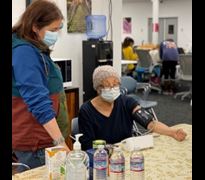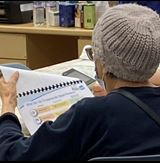Empowering Patients and Raising Blood Pressure Awareness in Unalaska
The American Heart Association and the Qawalangin Tribe of Unalaska have joined forces to address high blood pressure in the community by increasing access to the resources necessary for regular blood pressure management. Utilizing the American Heart Association’s Check. Change. Control. program curriculum as well as support from American Heart Association sponsors, the Qawalangin Tribe created a community self-monitoring blood pressure program.
blood pressure management. Utilizing the American Heart Association’s Check. Change. Control. program curriculum as well as support from American Heart Association sponsors, the Qawalangin Tribe created a community self-monitoring blood pressure program.
Nearly half of all adults living in the United States have high blood pressure, and the percentage of Alaskan adults who have ever been told they have high blood pressure by a health professional increased over 10 percent from 1991 to 2018. When left untreated, high blood pressure can lead to heart disease, stroke, kidney disease and other health threats, which is why active management of blood pressure is important. Most of the time, high blood pressure has no obvious symptoms so measuring blood pressure on a regular basis is the best way for people to know if they have high blood pressure. The good news is, with the right tools and information, anyone can check their blood pressure and take control of their health.
 This new program is run by the Qawalangin Tribe Wellness Department and provides the opportunity for community members to check out a blood pressure monitor at the library, community pool, recreation center or tribal headquarters office. When checking out a monitor, community members are provided with information on how to successfully take a reading and health education outlining what the readings mean. These community resources enable individuals to monitor their blood pressure on a consistent basis in between doctor’s visits, provide them with a strengthened understanding of their blood pressure numbers and empower them with information on what they can do to positively impact their blood pressure.
This new program is run by the Qawalangin Tribe Wellness Department and provides the opportunity for community members to check out a blood pressure monitor at the library, community pool, recreation center or tribal headquarters office. When checking out a monitor, community members are provided with information on how to successfully take a reading and health education outlining what the readings mean. These community resources enable individuals to monitor their blood pressure on a consistent basis in between doctor’s visits, provide them with a strengthened understanding of their blood pressure numbers and empower them with information on what they can do to positively impact their blood pressure.
When community members use this community service, they also receive information from their local clinics including how to access follow-up care. Self-monitoring blood pressure plays an important role in helping medical providers better diagnose and manage high blood pressure, plus empowers patients to take an active role in the process. Community outreach to spread the word about this new opportunity and share blood pressure information is planned via local radio stations, in tribal communications, through library promotion and through other local organizations.
 blood pressure management. Utilizing the American Heart Association’s Check. Change. Control. program curriculum as well as support from American Heart Association sponsors, the Qawalangin Tribe created a community self-monitoring blood pressure program.
blood pressure management. Utilizing the American Heart Association’s Check. Change. Control. program curriculum as well as support from American Heart Association sponsors, the Qawalangin Tribe created a community self-monitoring blood pressure program. Nearly half of all adults living in the United States have high blood pressure, and the percentage of Alaskan adults who have ever been told they have high blood pressure by a health professional increased over 10 percent from 1991 to 2018. When left untreated, high blood pressure can lead to heart disease, stroke, kidney disease and other health threats, which is why active management of blood pressure is important. Most of the time, high blood pressure has no obvious symptoms so measuring blood pressure on a regular basis is the best way for people to know if they have high blood pressure. The good news is, with the right tools and information, anyone can check their blood pressure and take control of their health.
 This new program is run by the Qawalangin Tribe Wellness Department and provides the opportunity for community members to check out a blood pressure monitor at the library, community pool, recreation center or tribal headquarters office. When checking out a monitor, community members are provided with information on how to successfully take a reading and health education outlining what the readings mean. These community resources enable individuals to monitor their blood pressure on a consistent basis in between doctor’s visits, provide them with a strengthened understanding of their blood pressure numbers and empower them with information on what they can do to positively impact their blood pressure.
This new program is run by the Qawalangin Tribe Wellness Department and provides the opportunity for community members to check out a blood pressure monitor at the library, community pool, recreation center or tribal headquarters office. When checking out a monitor, community members are provided with information on how to successfully take a reading and health education outlining what the readings mean. These community resources enable individuals to monitor their blood pressure on a consistent basis in between doctor’s visits, provide them with a strengthened understanding of their blood pressure numbers and empower them with information on what they can do to positively impact their blood pressure. When community members use this community service, they also receive information from their local clinics including how to access follow-up care. Self-monitoring blood pressure plays an important role in helping medical providers better diagnose and manage high blood pressure, plus empowers patients to take an active role in the process. Community outreach to spread the word about this new opportunity and share blood pressure information is planned via local radio stations, in tribal communications, through library promotion and through other local organizations.





